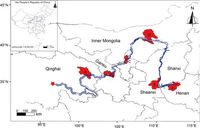The Yellow River, known as China's second-largest river, is a vital resource, providing water to over 160 million people and supporting 15% of the country’s arable land. However, recent analyses reveal that heavy metal contamination poses a serious threat to the health of this important river and its ecosystem. A study published on March 19, 2025, assessed the levels of eight heavy metals—iron (Fe), manganese (Mn), copper (Cu), nickel (Ni), zinc (Zn), chromium (Cr), lead (Pb), and cadmium (Cd)—in sediments from six urban areas in the middle and upper reaches of the Yellow River. The research notably highlights alarming pollution levels in the cities of Weinan and Luoyang.
The extensive research involved collecting sediment samples from a span of approximately 4,678 kilometers, covering an area of 772,000 square kilometers. Conducted between March and June 2023, the study aimed to comprehensively evaluate the distribution and ecological risk posed by these heavy metals in the river system. Researchers employed three evaluation methods: the enrichment factor, geo-accumulation index, and potential ecological risk index. These methods provided a robust framework for understanding the pollution levels in river sediments.
Heavy metal pollution is a persistent challenge exacerbated by rapid urban development and industrial activities. As pollutants from agricultural and industrial processes enter river systems, they can adversely affect aquatic life and increase risks to human health through the food chain. The analysis performed revealed concerning concentrations of chromium and cadmium across the six cities, indicating significant threats to the local environment. According to the findings, the contents of Cr and Cd are relatively high in the six cities, with Weinan and Luoyang identified as urban areas experiencing serious heavy metal pollution.
This research contributes to the growing body of knowledge surrounding heavy metal contaminants in river systems. Previous studies had focused on more localized assessments. This new study involves a broader analysis of heavy metal accumulation across multiple urban sectors, revealing the overall pollution status of the Yellow River, something that has been noted in various literature materials. The findings substantiate claims that the river, long affected by domestic and industrial wastewater discharge, is now facing intensified pollution levels.
Using sophisticated geographical analysis software, researchers effectively mapped the average content of heavy metals across the sampled urban areas. It was found that the average enrichment factors of the eight heavy metals ranked from highest to lowest were as follows: Weinan (1.73), Xining (1.60), Yinchuan (1.59), Lanzhou (1.56), Baotou (1.51), and Luoyang (1.44). These results illustrate varied levels of heavy metal pollution influenced primarily by industrial activities and dumping practices across these cities.
Among the significant findings, cadmium exhibited the highest degree of enrichment in Weinan and Luoyang, indicating localized pollution sources. The concentrations found were consistent with previous evaluations that ascribed the contamination to industrial production and wastewater discharge into waterways. The elevation of cadmium in these areas poses substantial ecological risks, meriting tailored intervention and remediation strategies.
Assessments of potential ecological risk indicated that while average values for copper, nickel, zinc, chromium, and lead were found to be below risk thresholds (less than 40), the average values for cadmium ranged between 80 and 160, categorizing areas in Xining, Baotou, and Yinchuan as high risk. Notably, Weinan and Luoyang had maximum potential ecological risk values exceeding 320, marking them as critical areas due to their heightened exposure to cadmium contamination.
While recommended action emphasizes the need for municipalities to better manage industrial emissions, the research asserts that current pollution levels endanger both the environment and public health. As heavy metals like cadmium can accumulate in the food chain, their journey from sediments to aquatic life underscores the necessity for interdisciplinary approaches in environmental governance. Addressing heavy metal pollution requires collaborative efforts across sectors to effectively manage and mitigate risks in river systems.
In conclusion, the realization of heavy metal pollution in the sediments of the Yellow River underlines a pressing environmental issue that demands immediate attention. As documented in this study, urban areas like Weinan and Luoyang stand out due to historical pollution practices leading to exceptionally high concentration levels of harmful pollutants. The results have significant implications not only for local ecosystems but also for public health due to potential food chain contamination. Therefore, relevant environmental governance departments should prioritize stringent controls on industrial wastewater discharge to protect and restore the health of the Yellow River.




